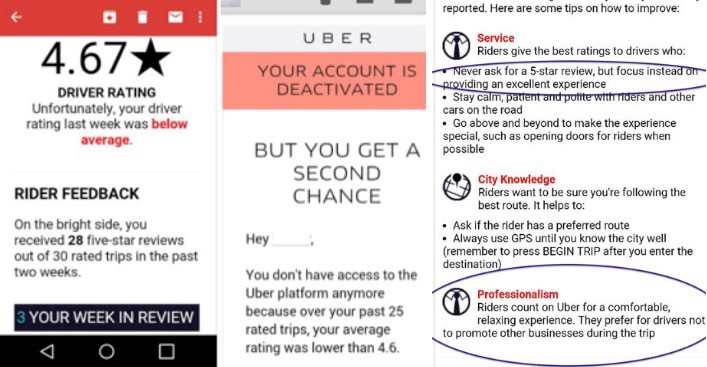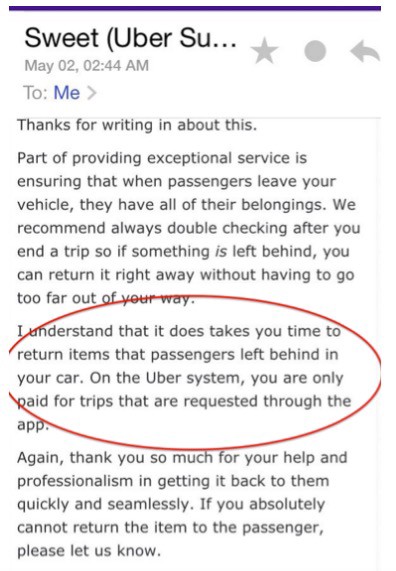The Uber Counterculture

The Data & Society Research Institute, with a researcher from NYU, conducted an extensive study of Uber’s labor issues though “sustained monitoring of online driver forums and interviewing Uber drivers.” It’s a surprisingly breezy document, given what it is, and bears out the types of things any frequent Uber passenger will eventually hear if she bothers to ask. It’s a survey, in a way, of a sort of on-demand labor version of a workplace culture developing among Uber drivers. And it isn’t an especially happy one.
Our findings coalesced around the dynamics of Uber’s system of surveillance and control over workers’ behavior. Our conclusions are two-fold: first, that the information asymmetries produced by Uber’s system are fundamental to its ability to structure indirect control over its workers; and second, that Uber relies heavily on the evolving rhetoric of the algorithm to justify these information asymmetries to drivers, riders, as well as regulators and outlets of public opinion.
Each section is fascinating. On Uber’s use of the language of entrepreneurship:
Drivers risk “deactivation” (being suspended or removed permanently from the system) for cancelling unprofitable fares. The Uber system requires drivers to maintain a low cancellation rate, such as 5% in San Francisco (as of July 2015), and a high acceptance rate, such as 80%
or 90%. Drivers absorb the risk of unknown fares, even though Uber promotes the idea that they are entrepreneurs who are knowingly investing in such risk. This discourse of entrepreneurship in the tech sector is the legacy of a Silicon Valley environment where highly skilled and mobile workers could take on risks and trade-offs to be part of the start-up world, but this rhetoric of risk has effectively been retooled to suit a contingent of lower-income workers who are recruited to perform service labor, not highly-skilled technical work.
On drivers’ contempt for Uber’s “driver-partner” characterization of their non-employment employment:
Drivers in this study generally treated the language as either a formality, hypocrisy, as irrelevant, or as a lever to press negotiations for more autonomy. However, the terms “partner” or “sharing economy” both work to express engagement and commitment to similar goals — in this instance, to align the driver’s goals and motives with that of the company through the articulation of social bonds — even when they are distinctly out of alignment Uber has full power to control and change the base rates its drivers charge. Uber’s agreement with its “Partners” (drivers) permits drivers to negotiate a lower fare, but not a higher one (Uber Partner Agreement Section 4.1, 2014). Some drivers report strategically ending a trip early, and thus lowering the fare for
the passenger, in the hopes of getting a higher rating. Rates, as well as minimum fares, vary across cities3; while Uber implies that drivers have the “freedom” to charge less, Uber still asserts almost total control over their drivers’ remuneration. At their lowest, these rates are discussed in forums as a net-loss for drivers after factoring in overhead costs. Uber also perennially and unilaterally changes the commission it takes from each ride, ranging generally from 20–30% for uberX drivers.
On drivers’ points of contact with the company, Community Support Representatives, who are themselves independent contractors held to driver-like performance standards and subject to driver-like indirect management.
[Their] responses often lack a nuanced understanding of the context or challenges of their work, and drivers have to be persistent to get the answers they seek to questions without a template response. Some perceive that software is creating initial responses based on the keywords in their text, and they refer to CSRs as “Uber’s robots.” The responses drivers receive often resemble generic FAQs, and some drivers write “escalate to manager” in the body of their text in the hopes of flagging a human supervisor more quickly. The role of the CSR more closely resembles customer service than management.
(This bears repeating: Uber doesn’t just outsource driving — it outsources its communication and conflict with those outsourced drivers.)
On Uber’s requests for drivers to help them preempt the same surge-pricing conditions that might allow them to make more money:
For drivers, the most tangible evidence of Uber’s data collection and analysis emerges through predictive scheduling communications that Uber sends to its drivers regarding surge pricing and high demand. Some drivers view this attempt at predictive scheduling as undermining their ability to make more money, and describe how they resist Uber’s attempts to predict and plan for “supply and demand”, such as by refusing to submit information about their intended working hours to Uber when that information is solicited. For example, Uber sent drivers in Atlanta notices that demand would be “off the charts” on Labor Day weekend, and surveyed drivers to “help us [Uber] plan supply and demand.”
On Uber’s ability to act with all the authority of an employer — making specific demands about how all its contractors must conduct their work — while maintaining their status as contractors.
Uber also exerts significant control over driver behaviors through its driver rating system: in it, passengers are empowered to act as middle managers over drivers, whose ratings directly impact their employment eligibility. This redistribution of managerial oversight and power away from formalized middle management and towards consumers is part of a broader trend in flexible labor: companies or platforms can create expectations about their service that workers must fulfill through the mediating power of the rating system.
(By setting specific consumer expectations for driver behavior; by giving customers the ability to rate their rides according to deviations from those expectations; by assigning the blame for those ratings, the true importance of which is concealed from the riders, entirely to the driver.)
Consider this line on Uber’s website regarding lost items: “Visit riders.uber.com/lost to retrieve a phone number to contact your driver and arrange the return of your item.” Then consider, as included in the study, this response given to a driver asking about item returns:

But perhaps the most interesting part of this study, and one that should be interesting even to ideological opponents who might be tempted to dismiss this research outright, is the outline it draws of Uber contractors’ attempts to take back power, either through crude organization or individual data collection. It surveys driver experiences as gathered from interviews but also from the numerous Uber driver forums, which together have thousands of members and display, in general, an oppositional attitude toward the company.

This is labor organization refracted through forum culture: there are calls for collective action next to flamewars; there are trolls and apparent astroturfers; there are political battles in which drivers mockingly tell other drivers “it’s a job, not a career.” There are memes! There is, in the absence of any sort of physical interaction or official means of driver communication, a work culture. Here is a post from a few weeks ago called “The Natural Stage Progressions of an Uber Driver.”
New Driver:
“You mean tell me I can make $1500/wk just by driving people around?! That’s not hard at all. Sign me up! I’m going to be the best Uber driver ever!”
3 Month Driver:
Uhhh….why are my ratings still dropping? Am I doing something wrong? I gave out water, and snacks like Uber told me to. Guess I’ll just have to try harder next time.
6 Month Driver:
“WOW another rate cut?! Man f$%# Uber! How are we supposed to make money with all these new drivers on the road? And they’re raising SRF too? Man….these Pax are really starting to get on my last nerve. Oh look…another water bottle/candy wrapper left on the floor!”
Veteran Driver:
“F$#& this s$#*! My only job is to get the Pax from point A to point B. To hell with Uber and their stupid Pax! And why the hell do they keep calling my damn phone? Learn how to drop a freaking pin people! I’m going to start giving more priority to Lyft from now on.”
Ex Driver:
“Just found a job as a pizza delivery guy. Uber can suck it! I’m out!”
(Sample response: “Correct down to the Dominos job…..”)
The study also mentions ways in which drivers attempt to combat the information asymmetry that defines their relationship with Uber. Hidden cameras!
A fare is “guaranteed” through the credit card a customer has on file, but Uber sometimes retracts it from a driver’s earnings if the company decides that the driver has erred. For example, a passenger may complain about an “inefficient” route. However, there may be physical obstacles invisible to the navigation system; passengers also sometimes instruct drivers to deviate from the GPS-suggested route, or ask for multiple drop-off points for a group of passengers. Some drivers have begun to self-monitor by acquiring dash-cams that face the passenger, so they can use their own surveillant “data” to produce a counter-narrative to the one that Uber presents. Others track their rides manually or through another app in order to verify their pay records. In lieu of other forms of empowerment, dash-cams and alternative logs enable drivers to resist Uber’s power to interpret events unilaterally.
This seems, however, more like last-resort recourse. It’s hard to imagine a situation in which a company that will kick you out of its system for dropping below a 4.6 rating would be supportive, in the long term, of a driver that presented unofficial passenger surveillance footage to contradict a fare claim. But, then again, such a driver might be less inclined to enthusiastically carry out the emotional labor required to maintain such a high rating, or might become bitter over time, in which case the ratings system, with the help of passengers, will sort things out on Uber’s behalf.
Anyway, this is how attempts to regain leverage seem to be starting, with anonymous communication in public and private and with individual attempts at data collection outside of the Uber app. It’s network versus network. It’s app versus app! What will companies like Uber do if these things blossom? A sufficiently massive public forum of disgruntled drivers could become a real problem in Uber’s attempts to find and retain drivers. A larger shadow-network of Uber drivers talking to each other and comparing their experiences could make attempts to manage and contain driver complaints through an email tree less tenable — perhaps more effectively than some Uber drivers’ explicit attempts at labor action. Likewise, Uber might be motivated to discourage drivers from monitoring passengers or making any types of recordings, or from banding together to collect alternate data — about pay, rides, etc — using other apps, because such a thing could be legitimately empowering.
New forms of labor communications are needed to address the inconsistencies of work that is characterized by algorithmic dynamism and ambiguous information flows to improve labor-platform relations. In a bricks- and-mortar workplace, the physical infrastructure is relatively reliable and unchanging. In a semi-digital workplace, small technical changes to the app’s interface, or built-in features that support a dynamic workplace, such as surge pricing and heat maps, can create ambiguity and confusion about worker (and passenger) expectations.
When people in the startup world talk about “algorithmic labor unions,” or a “right to an API,” they might want to look at what people are already doing, and what they’re trying to achieve. (Also worth considering in this context: Airbnb’s effort to mobilize its own users for political gain).
What do they want?
The same data Uber has, at least!
When do they want it?
Before they’re replaced by machines and herded to the next app? Idk actually!!
